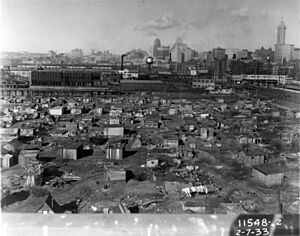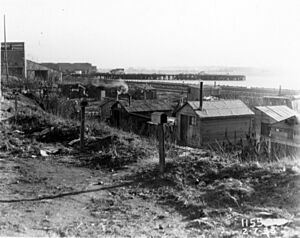Hooverville facts for kids
Imagine a time when many people lost their jobs and homes. During the 1930s, the United States faced a very tough time called the Great Depression. Because so many people became homeless, they built small, makeshift towns. These towns were called Hoovervilles. They got their name from Herbert Hoover, who was the President of the United States when the Depression started. Many people blamed him for the hard times. Hundreds of these Hoovervilles popped up all over the country.
Even before the Great Depression, some people were homeless. Big cities often had places for them to stay. But when the Depression hit, many more people needed help. Homeless people gathered in these shanty towns, often near free soup kitchens. These settlements were sometimes built on private land without permission. However, people often looked the other way because so many needed a place to live.
President Franklin D. Roosevelt started programs called the New Deal. One program, the Federal Transient Service (FTS), tried to help homeless people. It ran from 1933 to 1939. But even with these efforts, Hoovervilles remained common.
Some people living in Hoovervilles had building skills. They could build their homes from stone. But most people used whatever they could find. They built houses from wood crates, cardboard, or metal scraps. These homes usually had a small stove, bedding, and a few cooking tools. Men, women, and children all lived in Hoovervilles. Most residents were unemployed. They often relied on charities or begged for food.
People also made up other terms to criticize President Hoover. "Hoover blankets" were old newspapers used as blankets. A "Hoover flag" was an empty pocket turned inside out. "Hoover leather" was cardboard used to fix worn-out shoe soles. A "Hoover wagon" was a car pulled by horses because the owner could not afford gas.
After 1940, the economy got better. More people found jobs. Programs were started to remove the shanty towns. Because of this, all the Hoovervilles eventually disappeared.
Life in Hoovervilles
Some Hoovervilles tried to create their own rules and leaders. But most were just groups of shacks without much organization. This makes it hard to know exactly how many people lived in them. It also makes it hard to know if they were mostly men, or if women and children lived there too.
One special Hooverville was in Seattle, Washington. It had a clear government and kept good records. This Hooverville even had its own unofficial "mayor," Jesse Jackson. The city of Seattle allowed people to live there. They set a few rules for building and cleanliness. The city asked that women and children not live in the shantytown. "Mayor" Jackson helped make sure these rules were followed. He also led a group called the Vigilance Committee.
A man named Donald Francis Roy lived in Seattle's Hooverville. He kept detailed notes about the people living there. In his journal, he wrote that out of 639 residents, only 7 were women.
However, not all Hoovervilles were like Seattle's. Photos from other shantytowns show families, including women and children, living in their makeshift homes.
Hoovervilles were home to people from many different backgrounds. The tough economic times of the 1930s affected everyone. Migrant workers and immigrants also suffered from the lack of jobs. They made up a large part of the Hooverville populations across the country.
Donald Roy's 1934 records show the different groups living in Seattle's Hooverville. He wrote about Japanese, Mexican, Filipino, Native American, Costa Rican, Chilean, and Black men. Nearly 29 percent of the people were not white. Among the white population, there were English, Irish, Polish, Spanish, Italian, and Russian people.
Roy noted a special feeling of kindness among these different groups. He wrote that the usual social barriers between races did not exist in the Hooverville. Black and white men often shared homes. They showed friendship and support for each other. Roy also mentioned that only Filipino and Mexican men were sometimes separated. This was usually because of language differences, not because of racism.
Famous Hoovervilles

Hundreds of Hoovervilles existed across the U.S. during the 1930s. Here are some of the most well-known:
- Anacostia, District of Columbia: In 1932, a group of World War I veterans formed the Bonus Army. They wanted their military benefits paid early. They set up a large Hooverville here. Many veterans traveled illegally by riding freight trains to join the group. At its peak, about 15,000 people lived in this camp. The U.S. Army, led by General Douglas MacArthur, later destroyed the camp.
- Central Park, New York City: Many homeless families camped out on the Great Lawn in Central Park. This area was an empty reservoir at the time.
- Riverside Park, New York City: A shantytown also grew in Riverside Park, near 72nd Street, during the Depression.
- Seattle, Washington: Seattle had eight Hoovervilles in the 1930s. The largest one was on the tidal flats near the Port of Seattle. It lasted from 1932 to 1941.
- St. Louis, Missouri: In 1930, St. Louis had the largest Hooverville in America. It was made of four separate areas. This Hooverville was racially mixed. It relied on private help and had an unofficial mayor. It even created its own churches and social groups. This community lasted until 1936. Then, a federal program called the Works Progress Administration used money for slum clearance in the area.
Images for kids
See also
 In Spanish: Hooverville para niños
In Spanish: Hooverville para niños








